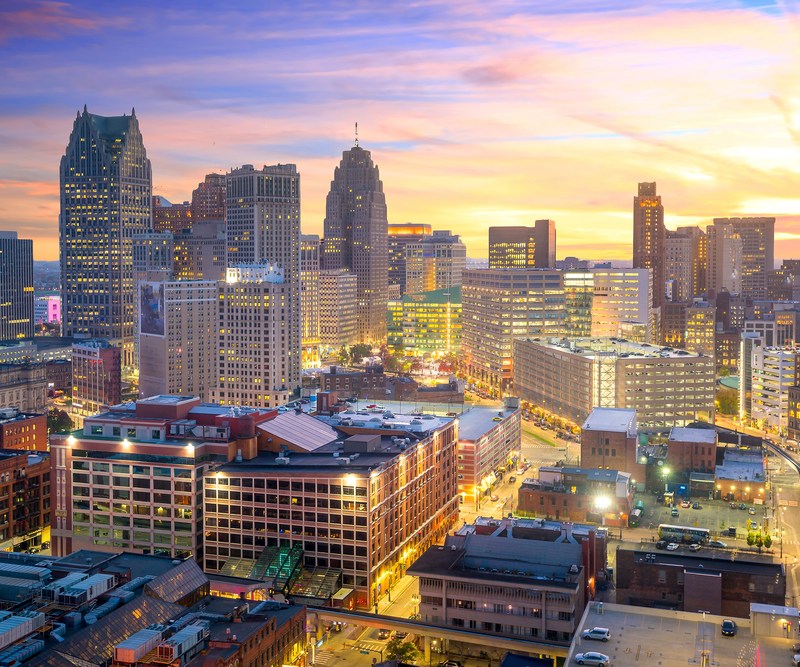
When you think of Detroit, post-apocalyptic images of abandoned vehicles and crumbling homes, churches, and streets probably come to mind. The city has had more than its fair share of hard times, but it’s still a beautiful city. Yes — beautiful! When it comes to beauty, Detroit has the best of both worlds: Not only is it located in a state known for its natural beauty (hello, Great Lakes!), but it’s also home to countless stunning man-made spots, many of which were financed and built during the city’s manufacturing boom. Here are 10 gorgeous places in or near Detroit that are worth checking out on your next visit to the Motor City.
Videos by TravelAwaits

1. Belle Isle Park
Belle Isle Park — also known as Belle Isle — is located on the Detroit River between the city and Ontario, Canada. The 982-acre park opened in 1880, and it features historic pavilions, bridges, and lagoons. The William Livingstone Memorial Lighthouse, first lit in 1930, is the only marble lighthouse in the world; the James Scott Memorial Fountain, completed in 1925, is a treasured Detroit landmark with 109 water spouts and intricate carvings.
While you’re there, be sure to check out the Belle Isle Aquarium, the oldest aquarium in the nation. Due to economic hardship, the city closed it in 2005, but the Belle Isle Conservancy raised the money to reopen it in 2012. Still a work in progress, the aquarium focuses mostly on North American species.
While admission to Belle Isle and its attractions is free, anyone bringing in a vehicle must pay for a recreation passport. The passport is good for up to a year, and it ranges in price from $5 to $31.

Michigan Opera Theatre
2. Detroit Opera House
Located in the city’s entertainment district, the resplendent Detroit Opera House began its life as the Capitol Theater in 1922. At the time, it had more than 4,200 seats and claimed to be the fifth-largest theater in the world. Although the building’s name has changed over the years, the gorgeous interior has remained much the same, with its grand, glorious frescoes, crystal chandeliers, and marble stairways. After a small fire in 1985, the theater closed its doors for several years before its reincarnation as the Detroit Opera House. The Michigan Opera Theatre purchased the building, renovated it, and made it its home. It now seats 2,700 patrons and hosts a variety of performances each year, both operas and live theater.

3. Sweetest Heart Of Mary Catholic Church
This grand Gothic Revival Catholic church, located near Detroit’s Eastern Market neighborhood, has a complex history. Founded by a group of Polish Catholics whose priest was suspended, Sweetest Heart of Mary was completed in 1893 and for a time, operated outside the auspices of the Catholic Church. Later, it rejoined the fold. The gorgeous house of worship is largely recognized as the grandest Polish church in the United States. Its stained glass windows won prizes at the 1893 Chicago Columbian Exposition, and the church’s spires house three enormous bells named Saint Mary, Saint Joseph, and Saint Barbara.
Detroiters from across town flock to attend the Sweetest Heart of Mary Pierogi Festival, which is held each August at the parish. Polka bands, beer, and the event’s trademark stuffed dumplings are all staples of the decades-old tradition.

4. Rivera Court
The Detroit Institute of Arts (DIA) had its day of reckoning after the city declared bankruptcy in 2013; an 11th-hour bargain negotiated by foundations, donors, and the state was the only thing that stopped the sale of the museum’s art to pay off the city’s debts. Thankfully kept intact, the collection remains one of the city’s cultural treasures, and the DIA’s Rivera Court is hands down one of Detroit’s most beautiful spots. Designed and painted by the Mexican muralist Diego Rivera (Frida Kahlo’s husband), this epic 27-panel masterpiece was completed in 1933. It celebrates Detroit’s spirit of innovation and the manufacturers who embodied that spirit.
The DIA is open every day but Monday; admission costs $14.
5. The Whitney
Want to dine at one of Detroit’s most magnificent mansions? Head to The Whitney near the Museum of Contemporary Art in Midtown. The Whitney was built by lumber baron David Whitney Jr. in 1894, when Detroit was enjoying its economic heyday. Whitney was the city’s wealthiest resident at the time, and it shows in his spectacular home. The Romanesque Revival mansion cost $400,000 to build ($9.5 million in today’s dollars) and was constructed of pink granite. The home boasts 22,000 square feet, including 10 bedrooms, 20 fireplaces, and stained glass windows crafted by Tiffany & Co.
In 1941, the Whitney family donated the mansion to the Wayne County Medical Society, which then transferred ownership to the Visiting Nurse Association. Visiting nurses lived at the home until the 1980s, when businessman Richard Kughn bought it, restored it, and opened a restaurant inside. The Whitney is now open for dinner daily, and it also features a Sunday brunch. Its lush gardens are open from Memorial Day to Labor Day.

6. Guardian Building
It’s not Detroit’s tallest skyscraper, but it might be the most beautiful. The Guardian Building — also known as Detroit’s Cathedral of Finance — is a National Historic Landmark. Once you step inside, you’ll immediately understand why.
Located downtown and constructed in the 1920s, the building began life as the Union Trust Building. It was completed in 1929, the year of the stock market crash. Union Trust went bust, but the building was saved by investors who renamed it the Union Guardian Building. Now known as the Guardian Building, this Art Deco dream maintains much of its lavish style: Its tile work, mosaics, murals, and stained glass are a feast for the eyes.
The building is home to office and event space, as well as a café located in its jaw-droppingly gorgeous ground-floor promenade. It’s a must-see for any architecture or Art Deco connoisseur.

7. General Motors Renaissance Center
Detroiters know that there’s no better view of their city than the view from the top of the RenCen, or the General Motors Renaissance Center. Located downtown and built in the mid-1970s, the RenCen is a 73-story glass and steel structure — and Michigan’s tallest building. It even has its own zip code (48243).
This mixed-use building, which includes offices, retail, restaurants, and a hotel, is grand all on its own, but for the real wow factor, head straight to the top. You’ll get a panoramic view of the city, as well as a view of Canada across the banks of the Detroit River. The building offers free tours twice daily during the week.

8. Cranbrook House & Gardens
For a bit of outdoor beauty outside the city, head to Cranbrook House & Gardens in the suburb of Bloomfield Hills, Michigan. Cranbrook is a 1908 Tudor Arts and Crafts home surrounded by 40 acres of lush, richly landscaped gardens; it was originally the summer home of George and Ellen Booth. The Booths, who made their fortune in the publishing business (Ellen was the daughter of James Edmund Scripps), later moved in on a full-time basis and remained at Cranbrook until 1949, acquiring art and design items including tapestries, wood carvings, and glasswork over the years. They deeded the home and its art collection to their Cranbrook Foundation. A volunteer auxiliary now preserves the home and gardens.
Cranbrook House is only open to the public during guided tour sessions, but the gardens are open daily from May 1 to October 31. Admission to the house costs $15 for adults and $10 for seniors, students, and active-duty military. Admission to the gardens is free in 2019, courtesy of PNC Bank, All Seasons Independent Living, Fleurdetroit, Holiday Inn Express Detroit-Birmingham, and Roberts Restaurant Group.
9. Apple Island
Open to tourists just one weekend each year, Apple Island is well worth your time. Located about 25 miles from Detroit, the 37-acre island on Orchard Lake is named for the apple trees that once grew there. Native Americans lived on the island for generations, but they were forced to cede the land to white settlers after the Treaty of Detroit in 1807. Legend has it that the Ottawa war chief Pontiac planned his rebellion on Apple Island and is buried there.
The gorgeous land was gifted to the local school district in the 1940s. Schoolchildren visit the island regularly, but ferried tours are open to the public only once a year, usually in June. Tickets cost $20.

10. Ann Arbor
For an all-American college-town experience, head to Ann Arbor, Michigan, only about a 45-minute drive from Detroit. The University of Michigan looms large in this city of 120,000. There are many gorgeous nooks and crannies on campus, including the renowned Nichols Arboretum. This urban green space, first planted in 1907, features a landscape of native and exotic trees, shrubs, and flowers, including an extensive peony garden. You’ll see why this is a popular place to relax and enjoy nature. Admission to the arboretum is free.
For something a bit more adventurous, consider canoeing the Huron River at the nearby Argo Cascades. The 3.7-mile course meanders through the heart of Ann Arbor, and the kayak cruise is a great way to spend an afternoon.
Photo Credit: Roland Shainidze / Shutterstock
Photo Credit: f11photo / Shutterstock
